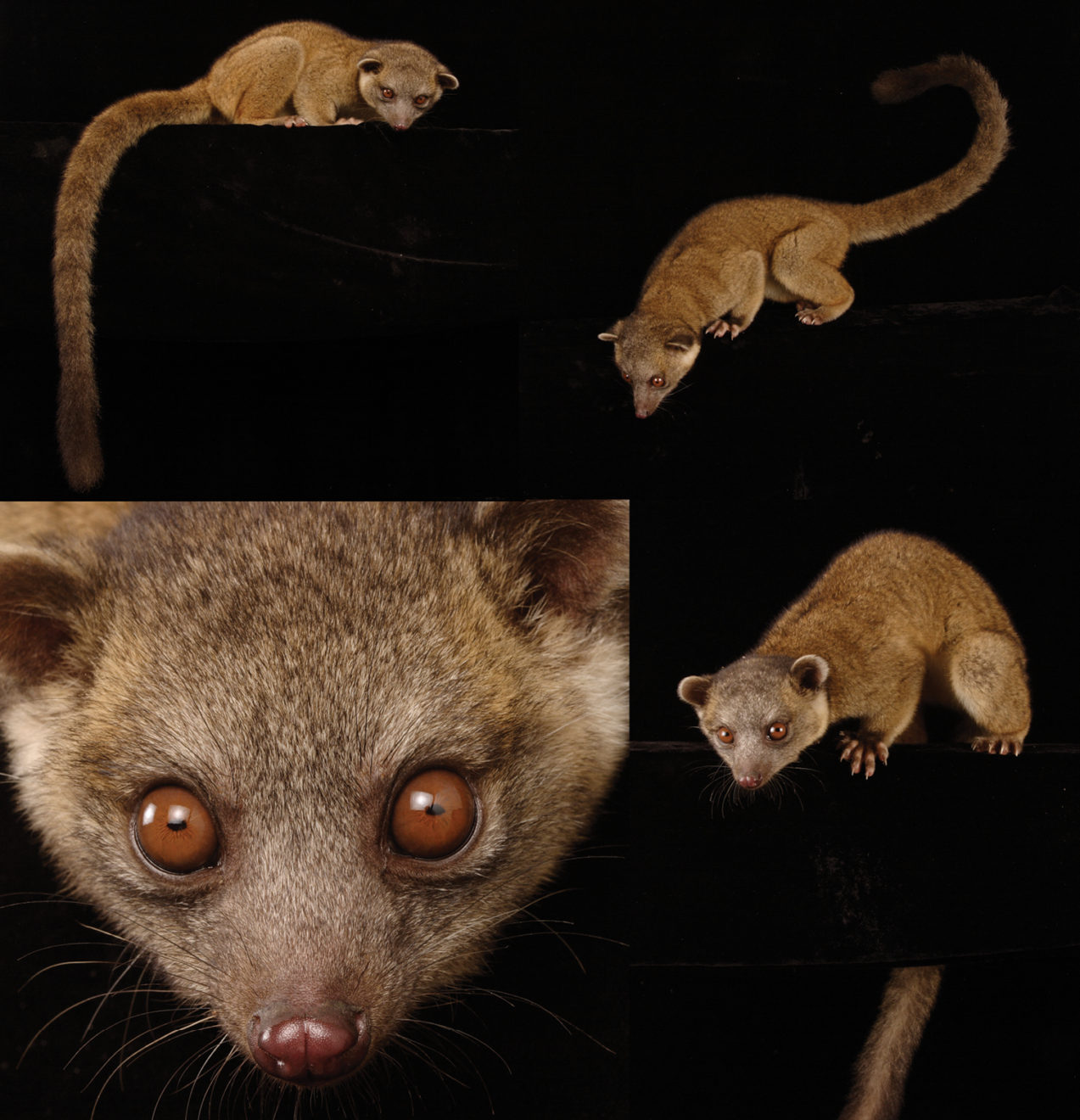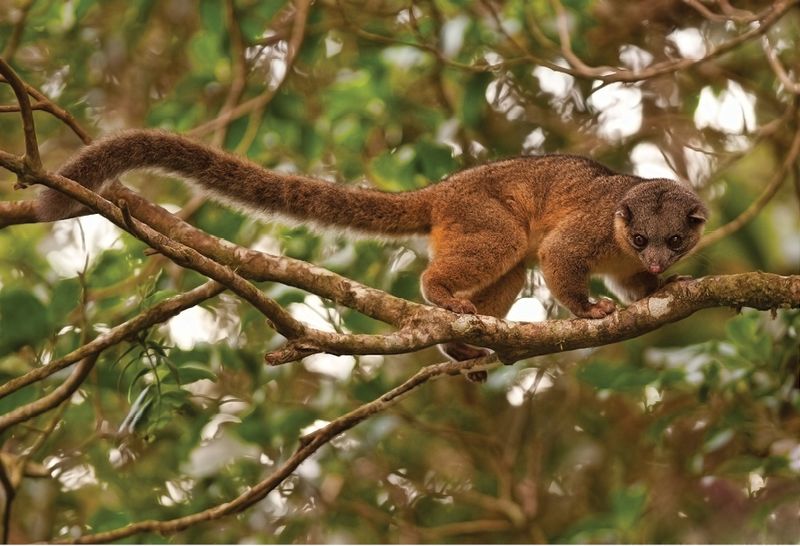The eastern lowland olingo (Bassaricyon alleni) is a species of olingo from South America, where it is known from the lowlands east of the Andes in Bolivia, Brazil, Colombia, Ecuador, Guyana, Peru and Venezuela. It is the only olingo species found east of the Andes. The Latin species name honors Joel Asaph Allen, the American zoologist who first described the genus Bassaricyon. This article will reveal further information about the fascinating olingo found in Guyana.
About The Olingo (Bassaricyon)
The genus Bassaricyon consists of small Neotropical procyonids, popularly known as olingos. They are native to the rainforests of Central and South America. They are arboreal and nocturnal and live at elevations from sea level to 2,750 m. Olingos closely resemble the kinkajou in morphology and habits, though they lack prehensile tails and extrudable tongues, have more extended muzzles, and possess anal scent glands. They also resemble galagos and certain lemurs.
Genetic studies have shown that the closest relatives of the olingos are actually the coatis; the divergence between the two groups is estimated to have occurred about 10.2 million years (Ma) ago during the Tortonian age, while kinkajous split off from the other extant procyonids about 22.6 Ma ago during the Aquitanian age.

P. Asimbaya y L. Velásquez [CC BY 3.0 (https://creativecommons.org/licenses/by/3.0)]
Species Of Olingos
There is disagreement on the number of species in this genus, with some taxonomists splitting the populations into as many as five species (adding B. pauli to the list below), two species (dropping B. medius and B. neblina), or just a single species (B. gabbi). Until recently, only the northern olingo (B. gabbii) was particularly well-known, and it was usually confusingly referred to simply as an olingo. Olingos are quite rare in zoos and are often misidentified as kinkajous.
An undescribed olingo, similar to but distinct from B. alleni, was discovered in 2006 by Kristofer Helgen at Las Maquinas in the Andes of Ecuador. He named this species B. neblina or olinguito and presented his findings on August 15, 2013. With data derived from anatomy, morphometrics, nuclear and mitochondrial DNA, field observations, and geographic range modeling, Helgen and coworkers demonstrated that four olingo species can be recognized:
- Bassaricyon alleni (Eastern lowland olingo) – Dwells in the lowlands of Guyana, Venezuela, and in Colombia, Ecuador, Peru and Bolivia east of the Andes
- Bassaricyon gabbii (Northern olingo) – Dwells in Central American, lowlands and highlands of Nicaragua, Costa Rica, and western Panama
- Bassaricyon medius (Western lowland olingo) – Dwells in lowlands of Panama and in Colombia and Ecuador west of the Andes
- Bassaricyon neblina (Olinguito) – A montane species endemic to cloud forests in the Andes of Colombia and Ecuador.
Features Of The Bassaricyon Alleni Olingo
- Size – The eastern lowland olingo is smaller than the northern olingo, but larger than the recently described olinguito (“little olingo”), the most montane member of the genus. It is larger than the western lowland olingo subspecies B. medius medius from west of the Andes, but about the same size as the B. m. orinomus subspecies from eastern Panama.
- Color – The pelage is slightly darker than the western species. They have a brown-grey body with a bushy tail and short rounded ears.
- Muzzles – Olingos are similar to kinkajous but lack prehensile tails and extrudable tongues, and have more extended muzzles.
- Length & Weight – It has a head-body length of 30 to 45 centimetres (12 to 18 in), with a tail length of 40 to 53 centimetres (16 to 21 in). It weighs 1.1 to 1.5 kilograms (2.4 to 3.3 lb).
- Close Relative – The closest relative of the eastern lowland olingo is the western lowland species, B. medius.
Scientific Classification Of The Bassaricyon Alleni Olingo
Olingo – Bassaricyon Alleni [Scientific name]
- Kingdom: Animalia
- Phylum: Chordata
- Class: Mammalia
- Order: Carnivora
- Family: Procyonidae
- Genus: Bassaricyon
- Species: B. alleni
In Guyana, Bassaricyon alleni is recorded only from two specimens, the type of beddardi (Pocock 1921a) and a specimen from Iwokrama Forest (Lim and Engstrom 2005). The holotype of beddardi was an adult female, from “Bastrica Woods, Essequibo River”, Guyana (Flower 1895; Pocock 1921a), and was an animal that lived in the London Zoological Gardens from 1894 to 1900 (Beddard 1900; Allen 1908).
Habitat & Diet Of The Olingo
Olingos are usually found in undisturbed evergreen forest; they are nocturnal and arboreal and typically solitary. They eat fruits, nectar, invertebrates and small vertebrates.
8 Facts About The Olingo
- The olingo is a nocturnal, arboreal omnivore related to the raccoon.
- Agile and active, the olingo stays high in the canopy, lightly passing through the branches, feeding quickly, and moving on.
- It is a noisy traveler but not so much as the kinkajou.
- Olingos use an alarm call if necessary, and less often a sneezing vocalization.
- They may feed in the same trees as kinkajous and night monkeys, but adults usually forage alone, and they are less social than kinkajous.
- During the day, olingos shelter in hollow trees. A female will have a single baby after a 73-74-day gestation period, and the infant is small and gray-brown with faint dark stripes.
- The olingo is not as adaptive as the kinkajou to disturbed forest or human-use areas. Perhaps it is for this reason that the olingo is not as common as the kinkajou, although they are still widespread.
- The olingo is less hunted than the kinkajou, but they are still very threatened by deforestation.
Olingo In Guyana
It can be very difficult to tell kinkajous and olingos apart. After reading this article, you would have learned some features and abilities of the olingo. So, whenever you are in the rainforest you would be able to spot an olingo and differentiate it from the kinkajous. When these animals were first collected in the Iwokrama Forest during a faunal survey, mammologist Burton Lim realised that one of the animals was an Olingo and not a Kinkajou. This event marked the first recorded sighting of an Olingo in Guyana for over 75 years.
Article References:
- https://www.stabroeknews.com/2011/03/20/features/kinkajous-and-olingos/
- https://www.anywhere.com/flora-fauna/mammal/olingo
- https://en.wikipedia.org/wiki/Eastern_lowland_olingo
- https://en.wikipedia.org/wiki/Bassaricyon
- https://www.gbif.org/species/2433586/treatments







